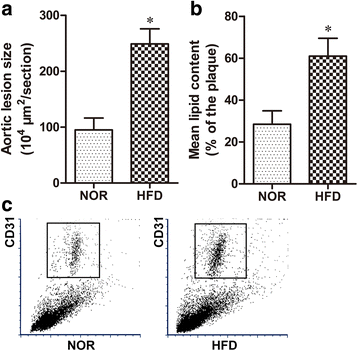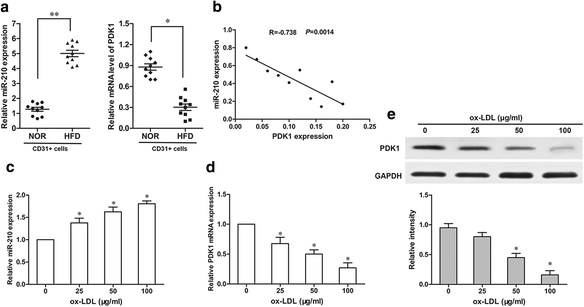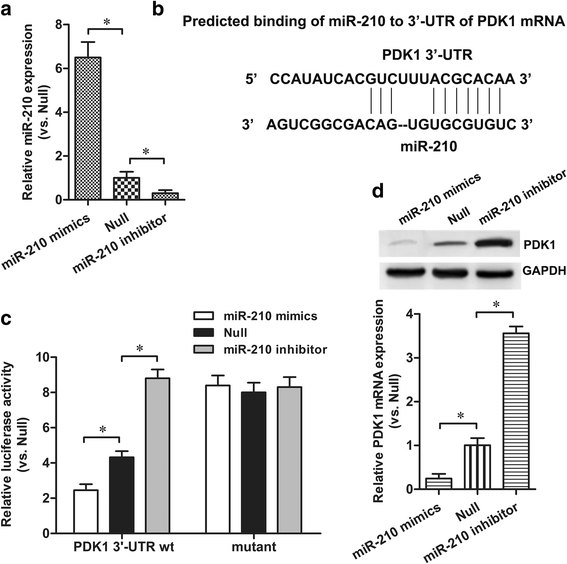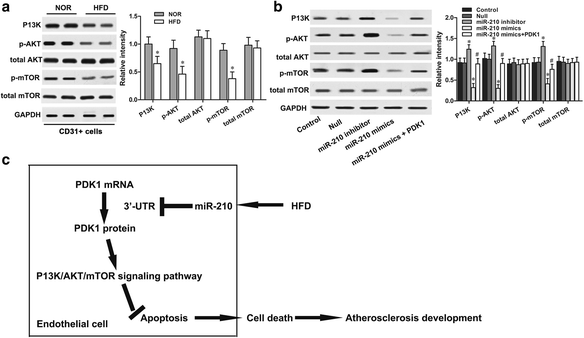MicroRNA-210 induces endothelial cell apoptosis by directly targeting PDK1 in the setting of atherosclerosis
- PMID: 28536634
- PMCID: PMC5415835
- DOI: 10.1186/s11658-017-0033-5
MicroRNA-210 induces endothelial cell apoptosis by directly targeting PDK1 in the setting of atherosclerosis
Abstract
Background: Atherosclerosis is a chronically inflammatory disease and one of the leading causes of deaths worldwide. Endothelial cell apoptosis plays a crucial role in its development. Several microRNAs (miRNAs) are reportedly involved in atherosclerotic plaque formation, including miRNA-210 (miR-210). However, the underlying mechanism of its role in endothelial cell apoptosis during atherosclerosis is still largely unknown.
Methods: A mouse model with atherosclerosis induced by a high-fat diet (HFD) was built in ApoE (-/-) mice. The levels of endothelial cell apoptosis were determined via flow cytometry. The expressions of miR-210 and PDK1 in purified CD31+ endothelial cells from mouse aorta were measured via RT-qPCR and western blot. Binding between miR-210 and the 3'-untranslated region (UTR) of PDK1 mRNA was predicted using bioinformatics analyses and confirmed with a dual luciferase reporter assay. The effects of miR-210 were further analyzed in an in vitro model using human aortic endothelial cells (HAECs) treated with oxidized low-density lipoprotein (ox-LDL).
Results: We found that the HFD mice developed atherosclerosis in 12 weeks and had a significantly higher percentage of endothelial cell apoptosis. The upregulated level of miR-210 in the HFD mice and HAECs inversely correlated with the level of PDK1. Inhibiting miR-210 expression significantly reduced HAEC apoptosis, as evidenced by the results of the MTT and flow cytometry experiments. Further analysis identified PDK1 as the target of miR-210 and showed that PDK1 overexpression reversed the pro-apoptotic effect of miR-210 through mediation of the P13K/Akt/mTOR pathways.
Conclusion: Our study suggests a novel role for miR-210 in the progression of atherosclerosis through the regulation of endothelial apoptosis. This indicates that miR-210 might have potential in treatment of atherosclerosis.
Keywords: ApoE (-/-); Atherosclerosis; PDK1, Endothelial cell apoptosis; miR-210.
Figures






Similar articles
-
Atherosclerosis-Associated Endothelial Cell Apoptosis by MiR-429-Mediated Down Regulation of Bcl-2.Cell Physiol Biochem. 2015;37(4):1421-30. doi: 10.1159/000438511. Epub 2015 Oct 22. Cell Physiol Biochem. 2015. PMID: 26489013
-
Upregulation of microRNA-876 Induces Endothelial Cell Apoptosis by Suppressing Bcl-Xl in Development of Atherosclerosis.Cell Physiol Biochem. 2017;42(4):1540-1549. doi: 10.1159/000479271. Epub 2017 Jul 19. Cell Physiol Biochem. 2017. PMID: 28723693
-
MicroRNA-142-3p Induces Atherosclerosis-Associated Endothelial Cell Apoptosis by Directly Targeting Rictor.Cell Physiol Biochem. 2018;47(4):1589-1603. doi: 10.1159/000490932. Epub 2018 Jun 27. Cell Physiol Biochem. 2018. PMID: 29949787
-
MicroRNA-126, -145, and -155: a therapeutic triad in atherosclerosis?Arterioscler Thromb Vasc Biol. 2013 Mar;33(3):449-54. doi: 10.1161/ATVBAHA.112.300279. Epub 2013 Jan 16. Arterioscler Thromb Vasc Biol. 2013. PMID: 23324496 Review.
-
Role of flow-sensitive microRNAs in endothelial dysfunction and atherosclerosis: mechanosensitive athero-miRs.Arterioscler Thromb Vasc Biol. 2014 Oct;34(10):2206-16. doi: 10.1161/ATVBAHA.114.303425. Epub 2014 Jul 10. Arterioscler Thromb Vasc Biol. 2014. PMID: 25012134 Free PMC article. Review.
Cited by
-
MicroRNAs as Potential Biomarkers in Atherosclerosis.Int J Mol Sci. 2019 Nov 7;20(22):5547. doi: 10.3390/ijms20225547. Int J Mol Sci. 2019. PMID: 31703274 Free PMC article. Review.
-
Postnatal Expression Profile of microRNAs Associated with Cardiovascular and Cerebrovascular Diseases in Children at the Age of 3 to 11 Years in Relation to Previous Occurrence of Pregnancy-Related Complications.Int J Mol Sci. 2019 Feb 2;20(3):654. doi: 10.3390/ijms20030654. Int J Mol Sci. 2019. PMID: 30717412 Free PMC article.
-
PCSK9i promoting the transformation of AS plaques into a stable plaque by targeting the miR-186-5p/Wipf2 and miR-375-3p/Pdk1/Yap1 in ApoE-/- mice.Front Med (Lausanne). 2024 Feb 26;11:1284199. doi: 10.3389/fmed.2024.1284199. eCollection 2024. Front Med (Lausanne). 2024. PMID: 38596793 Free PMC article.
-
HDAC1-mediated deacetylation of HIF1α prevents atherosclerosis progression by promoting miR-224-3p-mediated inhibition of FOSL2.Mol Ther Nucleic Acids. 2020 Nov 5;23:577-591. doi: 10.1016/j.omtn.2020.10.044. eCollection 2021 Mar 5. Mol Ther Nucleic Acids. 2020. PMID: 33510945 Free PMC article.
-
circ_CHFR regulates ox-LDL-mediated cell proliferation, apoptosis, and EndoMT by miR-15a-5p/EGFR axis in human brain microvessel endothelial cells.Open Life Sci. 2021 Sep 29;16(1):1053-1063. doi: 10.1515/biol-2021-0082. eCollection 2021. Open Life Sci. 2021. PMID: 34676300 Free PMC article.
References
MeSH terms
Substances
LinkOut - more resources
Full Text Sources
Other Literature Sources
Medical
Miscellaneous

